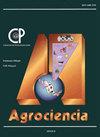POST-HARVEST CHARACTERISTICS OF MANGO FRUITS (Mangifera sp.) FROM SOCONUSCO, CHIAPAS
IF 0.5
4区 农林科学
Q4 AGRICULTURE, MULTIDISCIPLINARY
引用次数: 0
Abstract
Mango (Mangifera indica L.) is the second most important tropical fruit in the world. In the Soconusco region of Chiapas, Mexico, there is a large number of mango genotypes with a broad range of shapes, flavors, and aromas, with the potential to increase its cultivation. Therefore, the post-harvest characteristics of three creole mango genotypes, ‘Manililla’, ‘Cuero’, and ‘Manzana’ were evaluated and compared with the variety ‘Ataúlfo’. Fifty fruits from each genotype were harvested and stored at 20 °C and 75 % relative humidity; quality characteristics (epidermis/seed/pulp ratio, weight loss, color, firmness, °Bx, titratable acidity, ascorbic acid, pectimethylesterase enzymatic activity, phenolic acid and flavonoid content in epidermis) were evaluated under a completely randomized design. The results showed that ‘Manililla’ and ‘Cuero’ fruits had a significantly higher weight loss, while ‘Manzana’ and ‘Ataúlfo’ were similar in pulp content. The creole genotypes ‘Cuero’ and ‘Manzana’ had an attractive yellow-orange color, with red shading on the shoulders and orange in the pulp. The SST/AT ratio in ‘Manililla’ and ‘Cuero’ (71.1 and 62.6, respectively), was significantly higher in relation to ‘Ataúlfo’ (39.1) due to low acidity. ‘Manzana’ had higher total sugar content (30.3 g 100 g-1) and a firmer texture after six days of storage (dda). ‘Cuero’ showed greater weight loss and higher ascorbic acid content, 32 % more than ‘Ataúlfo’. The pulp content of ‘Manzana’ fruits was similar to that of ‘Ataúlfo’, with less weight loss and greater firmness, making it appealing for marketing.恰帕斯州SOCONUSCO地区芒果果实(Mangifera sp.)的采后特征
芒果(Mangifera indica L.)是世界第二重要的热带水果。在墨西哥恰帕斯州的Soconusco地区,有大量的芒果基因型,具有广泛的形状、风味和香气,具有增加种植的潜力。因此,对“Manililla”、“Cuero”和“Manzana”3种克里奥尔芒果基因型的收获后特性进行了评价,并与品种“Ataúlfo”进行了比较。每个基因型收获50个果实,在20°C和75%相对湿度条件下保存;在完全随机设计下评估品质特征(表皮/种子/果肉比、重量减轻、颜色、硬度、°Bx、可滴定酸度、抗坏血酸、聚甲基酯酶活性、表皮中酚酸和类黄酮含量)。结果表明,“Manililla”和“Cuero”水果的减肥效果明显更高,而“Manzana”和“Ataúlfo”的果肉含量相似。克里奥尔基因型“Cuero”和“Manzana”具有迷人的黄橙色,肩部有红色阴影,果肉呈橙色。由于酸度低,“manila”和“Cuero”的SST/AT比(分别为71.1和62.6)明显高于“Ataúlfo”(39.1)。“Manzana”的总糖含量较高(30.3 g 100 g-1),储存6天后(dda)质地更紧实。“Cuero”的减肥效果更好,抗坏血酸含量也更高,比“Ataúlfo”高32%。“Manzana”水果的果肉含量与“Ataúlfo”相似,重量减轻更少,硬度更高,这使得它对市场有吸引力。
本文章由计算机程序翻译,如有差异,请以英文原文为准。
求助全文
约1分钟内获得全文
求助全文
来源期刊

Agrociencia
农林科学-农业综合
CiteScore
0.50
自引率
33.30%
发文量
51
审稿时长
18-36 weeks
期刊介绍:
AGROCIENCIA is a scientific journal created and sponsored by the Colegio de Postgraduados. Its main objective is the publication and diffusion of agricultural, animal and forestry sciences research results from mexican and foreign scientists. All contributions are peer reviewed. Starting in the year 2000, AGROCIENCIA became a bimonthly and fully bilingual journal (Spanish and English versions in the same issue). Since 2007 appears every month and a half (eight issues per year). In addition to the printed issues, the full content is available in electronic format.
 求助内容:
求助内容: 应助结果提醒方式:
应助结果提醒方式:


